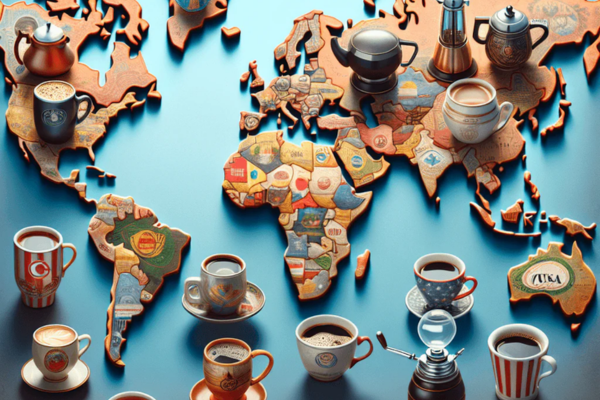
Coffee is a universal beverage that transcends cultures, languages, and traditions. From the rich espresso shots of Italy to the ceremonial coffee of Ethiopia, the way coffee is prepared, served, and enjoyed varies significantly across the world. These coffee rituals provide insights into the cultural values, social customs, and even histories of different regions.
Exploring how different cultures enjoy their daily brew is more than just understanding coffee—it’s about understanding the human connection that coffee fosters. This article takes you on a global journey to discover unique coffee rituals and the cultural meanings behind each cup.
1. Ethiopia: The Ceremonial Coffee Experience
In Ethiopia, the birthplace of coffee, the coffee ceremony is an essential part of daily life and social gatherings. This ritual is not just about drinking coffee; it is a symbol of hospitality, community, and respect.
The ceremony begins with the roasting of fresh green coffee beans over an open flame. The beans are then ground with a mortar and pestle and brewed in a traditional clay pot known as a “jebena.” The process is slow, deliberate, and filled with sensory experiences—from the aroma of roasting beans to the sight of rich, dark coffee being poured into small cups called “cini.”
The ceremony involves three rounds of coffee:
• Abol (the first round),
• Tona (the second round),
• Baraka (the third round, meaning “blessing”).
Each round symbolizes a deepening of connection and conversation. Popcorn or roasted barley often accompanies the coffee, enhancing the communal atmosphere.
The Ethiopian coffee ceremony is a reminder that coffee is more than a drink—it’s an experience of togetherness, patience, and tradition.
2. Turkey: Fortune-Telling and Friendship
In Turkey, coffee is more than a morning ritual; it is a cultural cornerstone, symbolizing friendship, hospitality, and even a glimpse into the future. Turkish coffee is brewed using finely ground coffee beans in a small pot called a “cezve.” The coffee is unfiltered, resulting in a rich, strong brew with sediment at the bottom of the cup.
One of the most distinctive aspects of Turkish coffee culture is the practice of fortune-telling, known as “fal.” After finishing the coffee, the drinker turns the cup upside down onto a saucer and waits for the grounds to settle and form patterns. These patterns are then interpreted to reveal insights about the drinker’s future.
Turkish coffee is often served with a glass of water and a piece of Turkish delight. The ritual is about more than just drinking coffee—it’s a shared moment of reflection, storytelling, and social connection.
The saying “A cup of coffee commits one to forty years of friendship” captures the essence of Turkish coffee culture: loyalty, hospitality, and the joy of sharing time with others.
3. Italy: The Quick and Intense Espresso Ritual
In Italy, coffee culture revolves around espresso—a small, strong shot of coffee that packs a punch. Italians are known for their precise coffee etiquette and quick, efficient way of enjoying their brew.
Espresso is typically consumed standing at a bar in a café, known as a “barista bar.” The ritual is brief, often lasting just a few minutes, but it is an essential part of the Italian lifestyle. Italians enjoy their coffee at specific times of the day, with clear rules:
• Cappuccino is reserved for the morning.
• Espresso is the drink of choice throughout the day and after meals.
The espresso ritual is about quality, simplicity, and social interaction. Italians don’t linger over their coffee; instead, they take a moment to savor the intense flavor and then continue with their day.
This approach to coffee highlights the Italian appreciation for craftsmanship, tradition, and the pleasure of small, daily rituals.
4. Sweden: The Social Tradition of Fika
In Sweden, coffee is intertwined with a cherished cultural tradition known as “fika.” Fika is more than just a coffee break; it is a moment to pause, socialize, and enjoy life’s simple pleasures. It often involves coffee, pastries (like “kanelbullar” or cinnamon buns), and good company.
Fika can happen at any time of the day, whether at home, work, or in a café. The ritual encourages people to take a break from their busy schedules and connect with friends, family, or colleagues. Swedes believe that taking time for fika contributes to a balanced and fulfilling life.
Fika reflects Swedish cultural values of well-being, community, and mindfulness. It emphasizes the importance of slowing down, sharing moments with others, and appreciating the present.
5. Japan: Precision and Craftsmanship in Coffee Preparation
Japan’s coffee culture blends tradition, precision, and artistry. While tea has deep roots in Japanese history, coffee has gained a significant following, especially in the form of the traditional “kissaten” coffee houses.
In a kissaten, coffee preparation is treated with the same care and attention as a tea ceremony. Popular brewing methods include:
• Pour-over (using a Hario V60),
• Siphon brewing,
• Hand-drip methods.
Baristas in Japan take meticulous care in every step of the process—from measuring the coffee grounds to controlling the water temperature and pour rate. The result is a cup of coffee that embodies precision, patience, and craftsmanship.
Coffee in Japan is often enjoyed in quiet, contemplative settings, reflecting the cultural values of mindfulness, respect, and attention to detail.
6. Cuba: The Sweet and Strong Cafecito
In Cuba, coffee is an essential part of daily life, often enjoyed in the form of “cafecito” or Cuban espresso. This small, strong shot of coffee is sweetened with sugar during the brewing process, resulting in a rich and syrupy flavor.
Cafecito is a social ritual, frequently shared with family, friends, and neighbors. It is common to prepare a batch of cafecito in a stovetop espresso maker called a “cafetera” and serve it in small cups. The drink is often accompanied by conversation and laughter.
Cuban coffee culture reflects the warmth, hospitality, and resilience of the Cuban people. It is a daily reminder of the importance of community, tradition, and enjoying life’s simple pleasures.
Conclusion
Coffee rituals around the world reveal the rich diversity of human culture and the shared need for connection, reflection, and enjoyment. From the elaborate ceremonies of Ethiopia to the quick espressos of Italy, each coffee ritual tells a story about the people who practice it.
These traditions highlight the fact that coffee is more than just a drink—it is a bridge between cultures, a symbol of hospitality, and a catalyst for conversation. Whether you’re enjoying a cafecito in Cuba, a fika in Sweden, or a fortune-telling session in Turkey, you are participating in a global tradition that has been centuries in the making.
So the next time you savor your cup of coffee, take a moment to appreciate the rituals, histories, and connections that make each brew special.
Enjoy your brew! ☕
